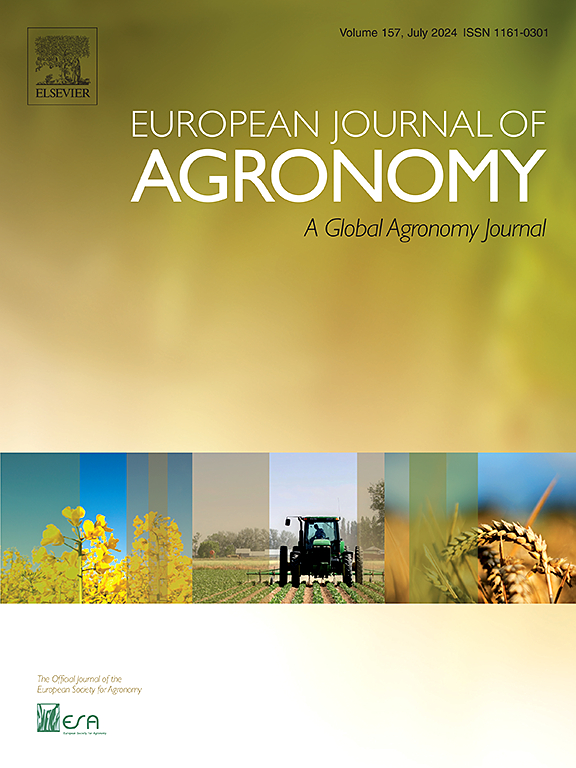夏玉米不同生育期热害触发阈值的确定——以黄淮海平原为例
IF 4.5
1区 农林科学
Q1 AGRONOMY
引用次数: 0
摘要
气候变化增加了玉米种植的不确定性,特别是当日最高温度(Tmaxd)超过玉米的临界阈值时。引发热害的阈值及其影响的严重程度在玉米的不同生长阶段有所不同。然而,目前还缺乏定量证据来确定夏玉米在这些特定阶段的HD临界阈值。因此,确定夏玉米不同生育期HD触发阈值对农业气象服务至关重要。本研究建立了一个多方法框架来确定HD阈值,综合盒状图、核密度估计和概率密度函数来确定阈值范围,然后利用ROC曲线和约登指数来确定关键阈值。结果显示,临界值分别为34.0°C (V0-VE)、34.1°C (VE-V6)、34.6°C (V6-VT)、34.8°C (VT-R1)、33.7°C (R1-R3)和32.9°C (R3-R6)。使用县级独立样本的验证表明,在所有阶段的平均准确率超过83%。通过分析2021 - 2023年各生育期HD连续日数和2023年出苗至拔节期Tmaxd,进一步揭示了HD的空间分布和演化特征。值得注意的是,HDD/HDF指数与相对气象产量呈负相关,特别突出了花期和灌浆期积热效应对减产的显著影响。这些发现验证了所确定的高温阈值的合理性,并为夏季玉米种植热害的监测和预警提供了有价值的理论见解,特别是在HHH平原。本文章由计算机程序翻译,如有差异,请以英文原文为准。
Identifying trigger thresholds for heat damage at different growth stages of summer maize: A case study of the Huang-Huai-Hai Plain, China
Climate change has increased uncertainties in maize cultivation, particularly when daily maximum temperatures () exceed critical thresholds for maize. The thresholds that trigger heat damage (HD) and the severity of its impacts differ across the various growth stages of maize. However, there is a lack of quantitative evidence defining the critical HD thresholds for summer maize at these specific stages. Therefore, determining the HD trigger thresholds for different growth stages of summer maize is crucial for agricultural meteorological services. This study developed a multi-method framework to determine HD thresholds, integrating box plots, kernel density estimation, and probability density functions to establish threshold ranges, followed by ROC curves and the Youden Index to identify critical thresholds. Results revealed critical thresholds of 34.0°C (V0-VE), 34.1°C (VE-V6), 34.6°C (V6-VT), 34.8°C (VT-R1), 33.7°C (R1-R3), and 32.9°C (R3-R6). Validation using county-level independent samples demonstrated an average accuracy exceeding 83 % across all stages. The spatial distribution and evolutionary characteristics of HD were further demonstrated by examining the maximum consecutive HD days from 2021 to 2023 at each growth stage, along with the from emergence to jointing stage in 2023. Notably, the HDD/HDF indices exhibited negative correlations with relative meteorological yield, particularly highlighting the significant impact of cumulative heat effects during flowering and grain-filling stages on yield reduction. These findings validate the rationality of the identified HD thresholds and provide valuable theoretical insights for monitoring and early warning of heat damage in summer maize cultivation, particularly in the HHH Plain.
求助全文
通过发布文献求助,成功后即可免费获取论文全文。
去求助
来源期刊

European Journal of Agronomy
农林科学-农艺学
CiteScore
8.30
自引率
7.70%
发文量
187
审稿时长
4.5 months
期刊介绍:
The European Journal of Agronomy, the official journal of the European Society for Agronomy, publishes original research papers reporting experimental and theoretical contributions to field-based agronomy and crop science. The journal will consider research at the field level for agricultural, horticultural and tree crops, that uses comprehensive and explanatory approaches. The EJA covers the following topics:
crop physiology
crop production and management including irrigation, fertilization and soil management
agroclimatology and modelling
plant-soil relationships
crop quality and post-harvest physiology
farming and cropping systems
agroecosystems and the environment
crop-weed interactions and management
organic farming
horticultural crops
papers from the European Society for Agronomy bi-annual meetings
In determining the suitability of submitted articles for publication, particular scrutiny is placed on the degree of novelty and significance of the research and the extent to which it adds to existing knowledge in agronomy.
 求助内容:
求助内容: 应助结果提醒方式:
应助结果提醒方式:


